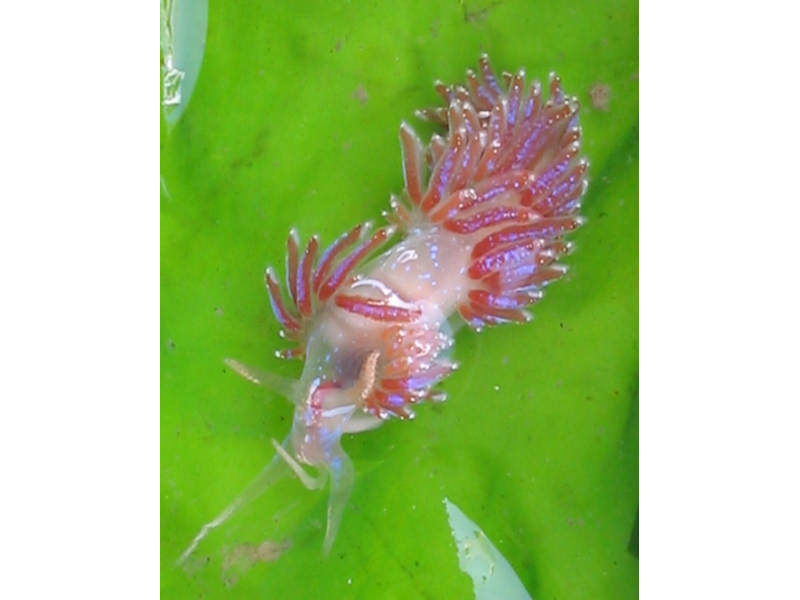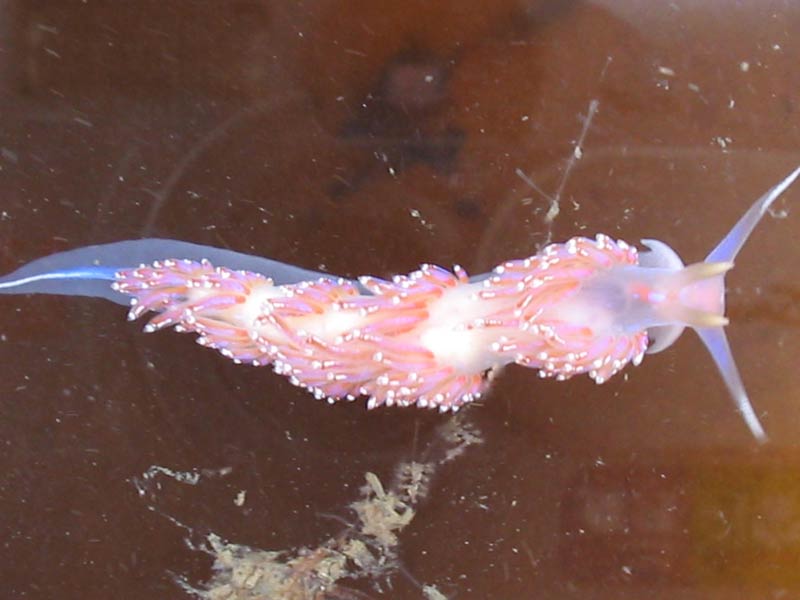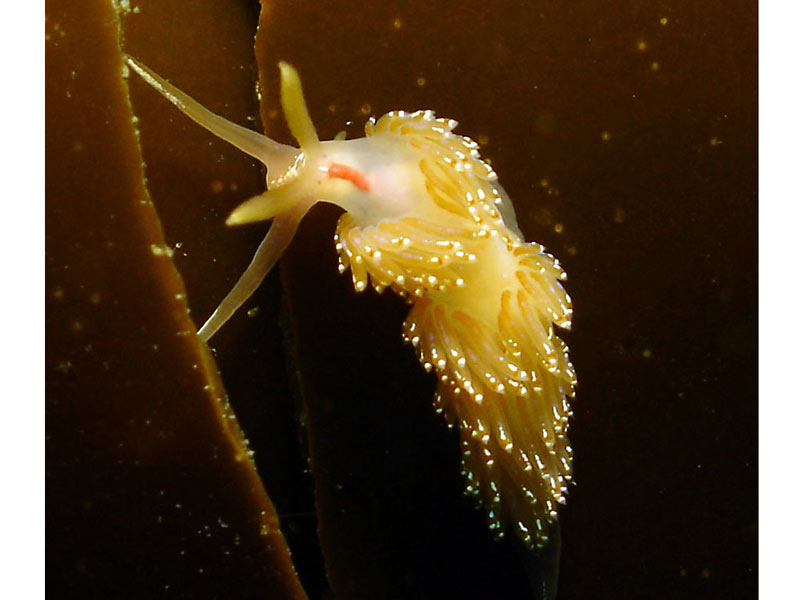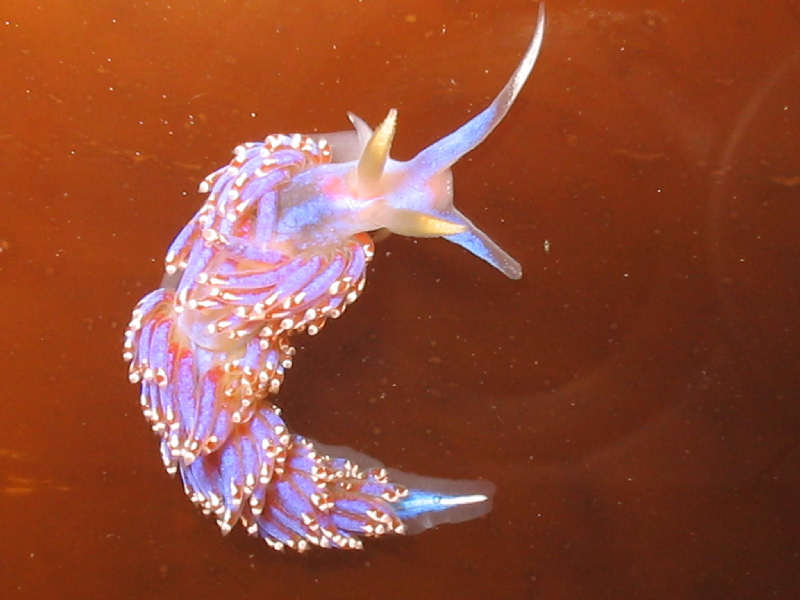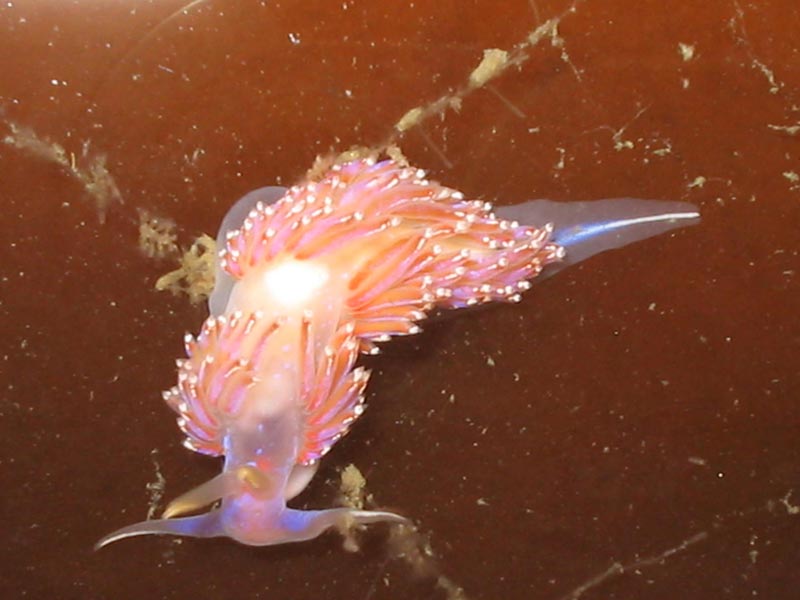Slender facelina (Facelina auriculata)
Distribution data supplied by the Ocean Biodiversity Information System (OBIS). To interrogate UK data visit the NBN Atlas.Map Help
| Researched by | Ken Neal | Refereed by | Admin |
| Authority | (Müller, 1776) | ||
| Other common names | - | Synonyms | Facelina auriculata (Müller, 1776) |
Summary
Description
Facelina auriculata is a slender sea slug up to 38 mm in length. It has a white body and numerous small purple cerata. The oesophagus is also visible just behind the rhinophores through the slightly translucent body. There are three pairs of processes at the front end of animal. Closest to the substratum are the short propodial tentacles, which are part of the foot, and are at 90° to the body in a relaxed animal. The much longer oral tentacles project from either side of the mouth and appear forward of the propodial tentacles in an extended animal. Behind the oral tentacles on the top of the animal are the rhinophores, which have a ribbed appearance.
Recorded distribution in Britain and Ireland
Recorded from all round Britain and Ireland except east and southeast England.Global distribution
-Habitat
Found under boulders in the intertidal and sublittoral on its prey species of hydroids, which include Tubularia sp., Obelia geniculata and Clava sp.Depth range
-Identifying features
- White body up to 38 mm in length.
- Back covered with numerous short cerata, which have a blue/purple hue and are streaked with white.
- Propodial tentacles, long oral tentacles and annulate rhinophores present, all streaked with white.
- Red oesophagus is visible through the body.
Additional information
Facelina auriculata occurs in two varieties: var. coronata is long and slender with the body extending rearward of the last cluster of cerata, while var. curta is shorter and broader that var. coronata and the body ends very near to the rearmost cluster of cerata (Thompson & Brown, 1976).
Listed by
- none -
Bibliography
Bruce, J.R., Colman, J.S. & Jones, N.S., 1963. Marine fauna of the Isle of Man. Liverpool: Liverpool University Press.
Crothers, J.H. (ed.), 1966. Dale Fort Marine Fauna. London: Field Studies Council.
Howson, C.M. & Picton, B.E., 1997. The species directory of the marine fauna and flora of the British Isles and surrounding seas. Belfast: Ulster Museum. [Ulster Museum publication, no. 276.]
Picton, B. E. & Morrow, C.C., 1994. A Field Guide to the Nudibranchs of the British Isles. London: Immel Publishing Ltd.
Picton, B.E. & Costello, M.J., 1998. BioMar biotope viewer: a guide to marine habitats, fauna and flora of Britain and Ireland. [CD-ROM] Environmental Sciences Unit, Trinity College, Dublin.
Thompson, T. E. & Brown, G. H., 1976. British Opisthobranch Molluscs. London: Academic Press. [Synopses of the British Fauna, no. 8.]
Datasets
Centre for Environmental Data and Recording, 2018. IBIS Project Data. Occurrence dataset: https://www.nmni.com/CEDaR/CEDaR-Centre-for-Environmental-Data-and-Recording.aspx accessed via NBNAtlas.org on 2018-09-25.
Centre for Environmental Data and Recording, 2018. Ulster Museum Marine Surveys of Northern Ireland Coastal Waters. Occurrence dataset https://www.nmni.com/CEDaR/CEDaR-Centre-for-Environmental-Data-and-Recording.aspx accessed via NBNAtlas.org on 2018-09-25.
Conchological Society of Great Britain & Ireland, 2018. Mollusc (marine) data for Great Britain and Ireland - restricted access. Occurrence dataset: https://doi.org/10.15468/4bsawx accessed via GBIF.org on 2018-09-25.
Conchological Society of Great Britain & Ireland, 2018. Mollusc (marine) records for Great Britain and Ireland. Occurrence dataset: https://doi.org/10.15468/aurwcz accessed via GBIF.org on 2018-09-25.
Fenwick, 2018. Aphotomarine. Occurrence dataset http://www.aphotomarine.com/index.html Accessed via NBNAtlas.org on 2018-10-01
Fife Nature Records Centre, 2018. St Andrews BioBlitz 2015. Occurrence dataset: https://doi.org/10.15468/xtrbvy accessed via GBIF.org on 2018-09-27.
Manx Biological Recording Partnership, 2018. Isle of Man historical wildlife records 1990 to 1994. Occurrence dataset:https://doi.org/10.15468/aru16v accessed via GBIF.org on 2018-10-01.
NBN (National Biodiversity Network) Atlas. Available from: https://www.nbnatlas.org.
OBIS (Ocean Biodiversity Information System), 2024. Global map of species distribution using gridded data. Available from: Ocean Biogeographic Information System. www.iobis.org. Accessed: 2024-04-20
South East Wales Biodiversity Records Centre, 2018. SEWBReC Molluscs (South East Wales). Occurrence dataset: https://doi.org/10.15468/jos5ga accessed via GBIF.org on 2018-10-02.
Citation
This review can be cited as:
Last Updated: 23/08/2007

